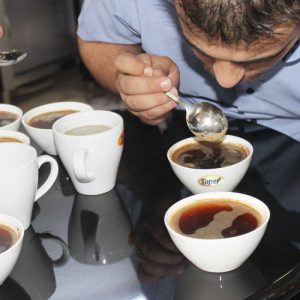Blind tasting
Blind tasting is the only test for the objective evaluation of coffee quality.
The coffee taster should taste coffee without knowing what type of coffee he is tasting. The bottom of the cups should be covered and labeled before pouring the coffee. Blind tasting is the most efficient way to learn coffee tasting and improving sensory tasting skills.
Hot coffee tasting
When coffee is in mouth, most of the aroma is sensed by nose. The tongue detects only bitter, sour, sweet, salty and umami flavors, but the nose detects thousands of aromatic compounds including the amount of concentration. Every coffee drink has its own aromatic signature consisted of hundreds of aromatic volatile compounds. Smelling provides the coffee taster to detect the difference of volatile compounds among the similar coffees with just one sniff. During tasting, most of the impression is sensed by smelling rather than by tasting.
Cold coffee tasting
Hot coffee is more acidic than the cold. Hot coffee tasting allows better evaluation of the acidity, brightness, taste, balance and many other characteristics. However, acidity covers the taste like a fog. When coffee is cold and the acidity disappears, the green coffee bean defects and the effects of roasting appear.
Interpreting the taste results
Coffee tasting and interpreting the results thereof depend on the skills and experiences of the roast master, barista and the coffee taster.
In order to make a proper analysis of coffee, coffee taster should control that the principles before the tasting are applied correctly.
The whole process up to tasting should be recorded for a real tasting. Otherwise, interpreting the taste results may be deceptive.
The coffee roasting machine, the roast master’s experiences, and the roasting process itself all comprise the flavor characteristics and the quality of coffee.
Results of the interpreted coffee taste analysis and the normals should be compared according to international tasting norms.
If the interpretation is thought to be inaccurate, tasting should be repeated.
We should keep in mind that; tasting is made by personal senses, and changes from one person to another is quite normal. But the results of tasting have to be close to the accurate. Otherwise quality and financial loss may occur.
Triangle cupping
Tasting two cups of same and one cup of different coffee samples together, in order to find out the similarities and differences, is called triangle cupping.
Coffee cups are marked as 1, 2, 3 or A, B, C, and then the coffee density, aroma and color are tested.
Using TDS meter
TDS meter analyses the solution. The coffee aromas dissolved in water as the result of brewing are the total of sensory characteristics. This analysis is made to control how reliable the brewing is made, and compared within the range of SCA standards.
The aroma list
SCAA (Specialty Coffee Association of America) published a diagram showing the aromas sensed during coffee tasting which is updated eventually.
Click on image to enlarge






